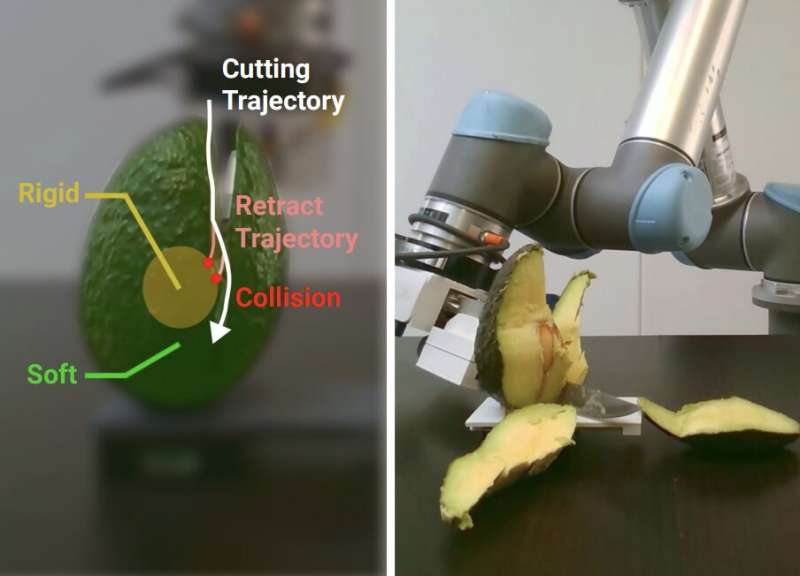RoboNinja is designed to cut multi-material objects with an interactive state estimator and adaptive cutting policy. Left: When the knife encounters a collision with the invisible core, the algorithm updates the core estimation and re-plans the cutting trajectory after a few retracting actions. Right: We deploy the learned model on a physical robot, allowing it to cut fruits in a way that maximizes the cut-off mass while minimizing collision occurrences. Credit: Xu et al
Humans innately learn to adapt their movements based on the materials they are handling and the tasks that they are trying to complete. When chopping specific fruits or vegetables, for instance, they might learn to cut around harder parts, such as avocado or peach seeds, or carefully eliminate the outer skin.
To assist humans with everyday tasks, such as cooking and preparing food, robots should also be able to effectively cut objects with mixed material compositions or textures. Transferring this capability to robots, however, has proved to be fairly challenging so far.
Researchers at Columbia University, CMU, UC Berkeley and other institutes in the U.S. recently created RoboNinja, a machine learning-based system that could allow robots to cut multi-material objects, particularly soft objects with hard cores. Their paper, published on the arXiv pre-print server, could ultimately help to enhance the capabilities of robots designed to help humans with chores and everyday kitchen tasks.
"In contrast to prior works using open-loop cutting actions to cut through single-material objects (e.g., slicing a cucumber), RoboNinja aims to remove the soft part of an object while preserving the rigid core, thereby maximizing the yield," Zhenjia Xu, Zhou Xian and their colleagues wrote in their paper. "To achieve this, our system closes the perception-action loop by utilizing an interactive state estimator and an adaptive cutting policy."
Xu, Xian and their colleagues set out to create a system that would allow a robot to effectively cut fruits like mangos, peaches and avocados, removing the soft pulp from the rigid seed in the middle. Their system's goal is to remove as much pulp as possible, while minimizing collisions with the central seed and consume a limited amount of power.
"The system first employs sparse collision information to iteratively estimate the position and geometry of an object's core and then generates closed-loop cutting actions based on the estimated state and a tolerance value," Xu, Xian and their colleagues wrote in their paper. "The 'adaptiveness' of the policy is achieved through the tolerance value, which modulates the policy's conservativeness when encountering collisions, maintaining an adaptive safety distance from the estimated core."
To evaluate their system for multi-material object cutting, the researchers created a cutting simulation environment that was more suitable for assessing the problem they were tackling. This environment features different scenarios in which a robot cuts objects made of a combination of soft and rigid materials.
"Existing simulators are limited in simulating multi-material objects or computing the energy consumption during the cutting process," Xu, Xian and their colleagues explained in their paper. "To address this issue, we develop a differentiable cutting simulator that supports multi-material coupling and allows for the generation of optimized trajectories as demonstrations for policy learning."
The results of simulations ran by Xu, Xian and their colleagues were promising, as RoboNinja allowed their simulated robotic gripper to remove a significant amount of soft materials from objects, while minimizing collisions with rigid parts and consuming a reasonable amount of energy. Subsequently, the team tested their framework on a real robotic gripper, to further validate its performance in real-world settings and while cutting objects with different core geometries.
"Our experiments show that our method is able to generalize well to novel core geometries and even real fruits," the researchers concluded in their paper. "We hope our experimental findings and the newly developed simulator will inspire future work on robot learning involving interactions with multi-material objects."
More information: Zhenjia Xu et al, RoboNinja: Learning an Adaptive Cutting Policy for Multi-Material Objects, arXiv (2023). DOI: 10.48550/arxiv.2302.11553
Journal information: arXiv
© 2023 Science X Network
























